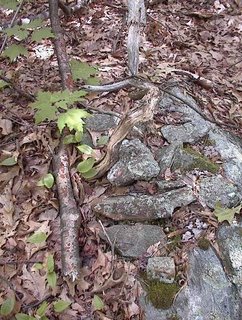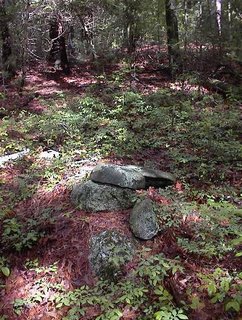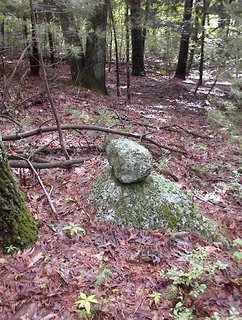by geophileOne of the realities we face in this research is that many of our suppositions and theory formulations about sites and elements of sites are likely to remain forever unverifiable. No book or bark scroll will ever be dug up that will contain lists of sites, what they stood for and were used for, and what elements of them represented what important persons, gods, or concepts.
 A human face simulacrum very similar to one found at the Oley Hills site
A human face simulacrum very similar to one found at the Oley Hills siteFor example, while we can be sure that simulacra were noticed and honored if not worshipped by many ancient people, we can't be certain that those we find at any given site were noticed or a part of ceremony.
Here are three pictures taken at one New Jersey rock outcropping, maybe twenty or thirty miles east of Oley Hills on one of a related set of hills. From this outcropping, there was a clear view of Delaware Water Gap. At the same site we noticed a paw-shaped cut-out, possibly a mortar, a photo of which I have posted previously, in a flat rock near the precipice.
 A possible visage in the mountain-face itself, looking toward Delaware Water Gap. The tree in front of it is large, not a sapling.
A possible visage in the mountain-face itself, looking toward Delaware Water Gap. The tree in front of it is large, not a sapling.Are these face forms of any significance at all? They say the human mind automatically tries to find faces in everything it looks at. Maybe my seeing these things in rock is more related to excess dopamine (cause of much 'inappropriate salience attribution') in my brain than to anything related to the sacred landscape. On the other hand, I have among my files many, many pictures of stones taken at outcroppings and at stone pile sites, but those that appear to be representational are very rare.
 A third face. It may be facing north or northeast.
A third face. It may be facing north or northeast.
The woman in the picture is named Mary.Maybe the faces do have something to do with what the site stood for in the time of the stone builders, or maybe not. Three obvious ones at a small site seemed unusual at the time, but that doesn't rule out chance.
The best thing we can do is keep alert and try to notice these and other forms and phenomena whenever we visit sites. As we compile this information, patterns may emerge.
 Here is a rock pile incorporating a coil of barbed wire like a "wreath". Tim Fohl found this in Townsend.
Here is a rock pile incorporating a coil of barbed wire like a "wreath". Tim Fohl found this in Townsend. Here, a tangle of straight wire sits on top of the pile and collects debris.I found this one in Bolton in the same conservation land as the broken plow tip pile.
Here, a tangle of straight wire sits on top of the pile and collects debris.I found this one in Bolton in the same conservation land as the broken plow tip pile.














































